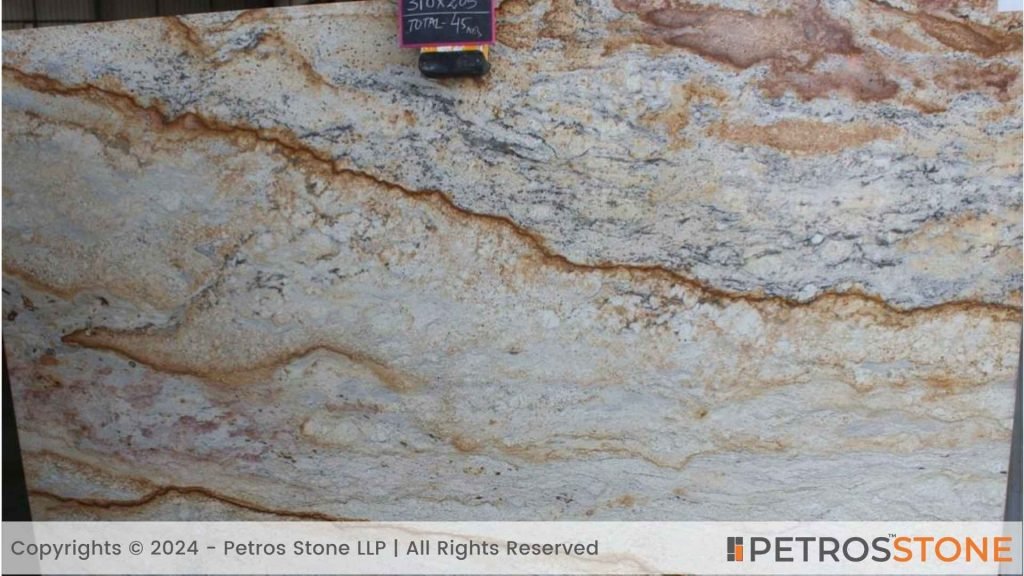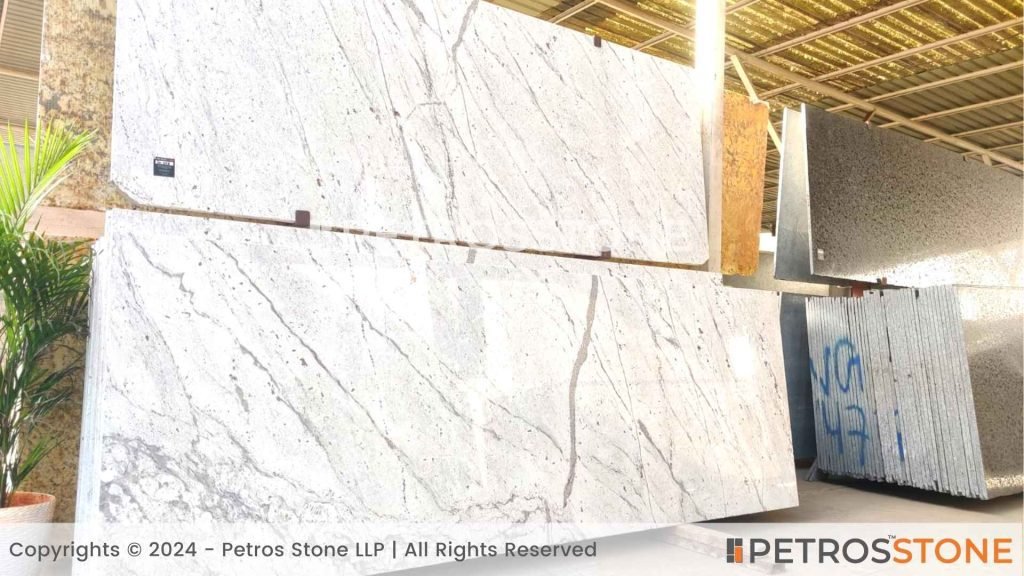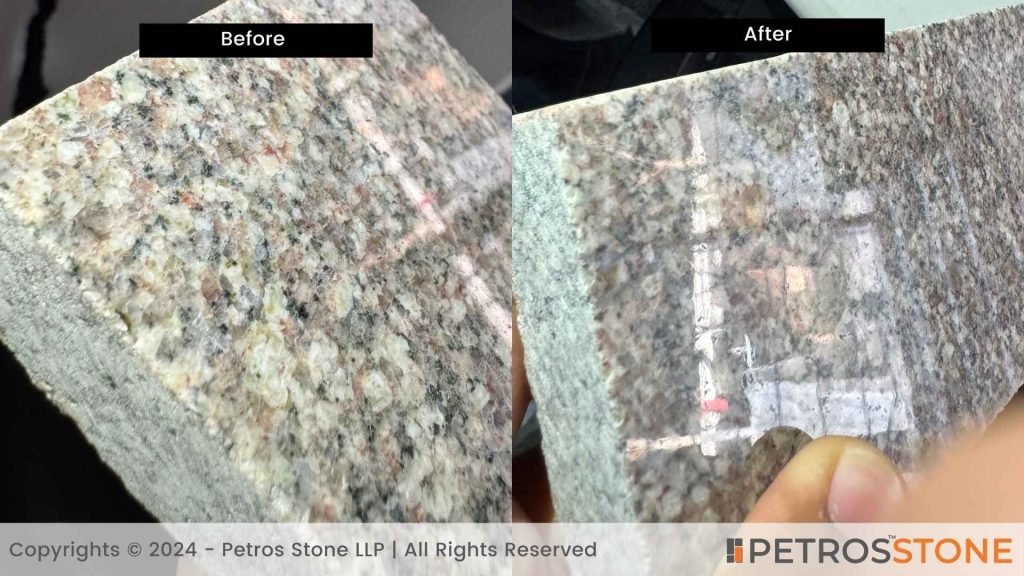
This guide explains in detail the different granite grades, describes why grading is more of an art than a science, and offers some guidance on how to select the right grade of granite for your needs. So stay tuned till the end!
Granite stands as one of the most popular natural stones worldwide, celebrated for its exceptional durability, elegant appearance, and versatility. However, not all granite available in the market offers the same quality. Learning about the grades and levels of granite will assist any homeowner or designer in selecting the right granite for the intended use, such as countertops and flooring.

What Are Grades of Granite?

Granite grading systems classify granite slabs based on their quality, durability, and appearance.
Grading compares granites by evaluating color variation, toughness, permeability, and the presence of defects.
While there’s no universal grading system for granite, most suppliers and manufacturers follow a tiered approach, often using classifications like:
- Grade A, B, C, or
- Levels 1, 2, 3
These grading systems simply try to ensure that the granite quality and price are in harmony with the customer’s requirements, expectations, and budget range.
This helps avoid expensive missteps and ensures your granite is suitable for your project.
Understanding granite grades helps you identify the stone’s origin, polishing quality, and potential durability.
Grades of Granite: A, B, C Explained
Grade A (High-End Granite)
Characteristics:
- Consistent colour and pattern.
- No cracks or chips or any other natural defect.
- Dense and resilient, it has a low absorbency.
Applications:
- Luxury kitchen countertops, flooring solutions, and decorative purposes.
Cost:
- Grade A granite represents the highest quality and typically comes at a premium price. It is often chosen for durable, high-end projects.
- It suits applications demanding uncompromised aesthetics and functionality, such as luxury residences and premium hotels.

Grade B (Mid-Range Granite)
Characteristics:
- Contains some imperfections like inconsistent colour gradients or patterns.
- May have some forms of defects that do not in any way affect the strength of the product.
- Good durability but may need extra sealing depending on its use.
Applications:
- Average projects include countertops for residential homes or backsplashes.
Cost:
- Cheaper than Grade A but still has a good quality range of products.
- Mid-range granite is quite common among people who are looking for quality and are not willing to spend a lot of money.

Grade C (Entry-Level)
Characteristics:
- Defects in terms of colour or contrast.
- May be softer and more porous; that is, they may need special care and attention.
- It is ideal for applications that require both impeccable aesthetics and functionality, such as luxury residences and premium hotels.
Applications:
For low-cost clients, rental properties, or small facilities.
Cost:
- It is the cheapest of the three, therefore suitable for buyers who are not willing to spend a lot. Grade C granite can still give a good look and feel to the structure if well-chosen and well-maintained.
- This grade is usually popular in uses where aesthetics are more important than usage, such as in interior cladding or in secondary work surfaces.(where the surface of granite won’t be visible and is only used to provide structural strength)


Granite Levels: 1, 2, 3
Granite levels are another way to classify granite, primarily based on price and appearance. Here’s a breakdown of the common levels:
Level 1 (Entry-Level Granite)



- Usually imported from countries with cheap labour, such as China or Brazil.
- They include thin slabs with simple patterns and limited colour choices.
- Economic but may need some more attention from time to time.
- Generally thin, around ⅜ inch.
- This granite is perfect for applications demanding impeccable aesthetics and functionality, including luxury residences and premium hotels. Although they have a very basic design, they can also add elegance to spaces with appropriate design features.
Level 2 (Mid-Tier Granite)



- More complex patterns and richer colours.
- Thicker (around ¾ inch) and more durable plates than level 1.
- For homeowners, this is a perfect place to find quality granite at a good price.
- Level 2 granites are fairly mid-range when it comes to price, yet they are very classy.
- Homeowners widely use it for residential projects due to its perfect blend of strength and aesthetic appeal.
Level 3 (Premium Granite)






- Unique and exotic patterns with vibrant colours.
- Well-shaped slabs with less variation in size and fewer defects.
- Applied in the luxurious houses and the prestigious business premises.
- It is at this level that one may find some of the rare imported granites used due to their elegance and durability.
- Level 3 granite is often used in custom interior design solutions and high-end architectural & design works.
Why Quality Grading in Granite Is a Little Subjective

Granite grading isn’t governed by universal standards, making it somewhat subjective. Here’s why:
Natural Variability of Granite:
Granite is a type of natural stone, and it means that it can have a different look even if it is taken from the same quarry. Granite is a natural stone, meaning its appearance can vary significantly even when sourced from the same quarry. Additionally, these variations add uniqueness to each slab, making it a popular choice for distinct design projects.
Small variations in the pattern, the texture, and the colour give each slab a distinctive character.
Some pattern variations can appear to be ugly for some people, and the same vibrations can appear to be attractive designs to other people. Hence, the grading of slabs based on their appearance is a little bit subjective.
This is an advantage of granite in as much as it makes it hard to grade. None of the slabs are the same, which is the beauty of granite. Granite, being a natural stone, features a unique appearance that can vary greatly, even when extracted from the same quarry. Moreover, these natural variations enhance the individuality of each slab, making it an excellent choice for distinctive design projects. This is an advantage of granite in as much as it makes it hard to grade.
Grades Differ with Supplier and Market Differences:
The same granite may receive different grading from the suppliers depending on the market conditions in the given area.
For instance, a slab that has been graded as level one in one market may be graded as level two in another market.
It also differs with the processing techniques used and the local market preferences of the consumers of the product.
Grade Based on Applications
A granite’s grade may change depending on its intended use.
For example, a stone with minor imperfections might be unsuitable for countertops but perfect for flooring. The intended application often dictates what is acceptable in terms of grading.
Certain imperfections may even enhance the aesthetic appeal depending on the design context.
Why Is It Important to Grade Granites?

Despite its subjectivity, grading granite is crucial for several reasons:
- Helps in Budget Planning: Grades are important because they help buyers make decisions on the products they need without having to spend more than they have to.
- Ensures Quality Assurance: Grading brings out the potential imperfections, helping buyers assess durability and maintenance requirements. It enables buyers to prepare for the cost of maintenance and sealants in a better way.
- Supports Design Decisions: Grades and levels are used by the buyers as tools to pick granite that is suitable for their designs and intended use. For instance, projects of high standards require the uniformity and durability of Grade A or Level 3 granite. Grading aids in decision-making, particularly for large-scale projects.
How to Identify Grades of Granite

Here is a detailed article on how to check the quality of granite properly; most of them don’t require any special tools. Click here.
Distinguishing between the different grades of granite can be a difficult task, and it helps to know what to look for. Here’s what to look for:
1. Visual Inspection


- Uniformity: High-grade granite has a uniform colour and design throughout. The colour or texture may be more apparent in lower-grade granite.
- Imperfections: Search for cracks, chips, or any other marks that are part of the stone. The premium granite will be less defective. The appearance of the granite is normally the first way to tell the quality of the granite. A mirror-like finish is usually associated with high quality and hence an even surface.
2. Thickness



- Premium granite slabs are usually more than 3 cm thick, while the general granite is 2 cm thick.
- Both durability and the aesthetic appearance are affected by the thickness.
- They are also least likely to crack as compared to the thinner ones.
3. Surface Finish
- It could also be observed that the higher grades have a more refined and smoother surface than the lower grades.
- The finish is very important in deciding the quality of the work and the cost.
- Search for a reflective sheen in order to tell that it is a high-quality piece of granite.
4. Hardness Test
- If the granite is hard, then it falls under a high grade.
- High-grade granite is not easily scratched or chipped.
- For confirmation, you should use a Mohs scale test, or you could ask your supplier.
- Tougher granite is ideal for busy areas, such as countertops in the kitchen.
5. Check the Origin
- The high-quality granite is sourced from countries like Brazil, India, and Italy since these countries have quality granite.
- Lower grades may come from areas of lower costs.
- Granites imported are generally perceived as being of high quality and more luxurious.
How to Check the Quality of Granite?
Read a detailed overview on how to check granite quality by clicking above.
To summaraize, in order to ensure you’re getting high-quality granite, follow these steps:
- Check for Cracks and Fissures: Check the surface under the light to see if there is any crack or any other damage on the surface. Qualitative consistency means no interruption of the pattern.
- Test Porosity: Pour water on the surface. The best granite will only have a small amount of water intake. Porosity affects the stain and the durability of a stone. Sealing can solve porosity problems in mid-grade granite to some extent.
- Verify Test Reports: You should always ask for a test report from your supplier. These reports contain information on the granite’s hardness, toughness, and permeability; that is, the ability of the granite to absorb liquids. To ensure your purchase is legal and ethical, it is crucial to obtain verified reports. Such reports also do assist in the comparison of different granite slabs.
- Hardness Test: A simple scratch test will show how hard the stone is and how well it can be worn down. The more durable granites are less prone to scratching, etc., in areas of high traffic.
For a more detailed list, please refer to our granite quality guide. Generally, it is easier to trust suppliers that meet the standard quality requirements of the industry.

Which Grade of Granite Should You Buy?
It is recommended that you choose a grade of granite that will meet your particular requirements and your financial plan.
- For High-End Projects: Grade A and Level 3 granite is the best for luxury homes and spaces that need to have an exquisite and long-lasting look. This grade is perfect for kitchens, hallways, or rooms that are used a lot or for focal points. Most of the time, this grade features exotic patterns and bold veining.
- For Mid-Range Applications: The second-grade granite, and maybe level 1 or level 2 granite, is suitable for residential use in countertops or backsplashes. This grade offers strength without having to spend much money. It is a suitable option for use in day-to-day life in homes.
- For Budget-Friendly Projects: The Grade C and Level 1 granite is ideal for small applications or rental homes. Even though it is cheaper than the first two, it is still possible to get great looks from this if one is careful in their choice. The fact that it is economical makes it suitable for use in large projects that require a small capital base.
Get Help
Granite grades and levels are a great way of ensuring that you get the right stone for your project.
From being able to distinguish between grades A, B, and C to the ability to distinguish between levels one, two, and three, grading systems help in decision-making and guarantee that you get the quality and the look that you want.
For advice and an extensive variety of high-quality granite, visit Petrosstone or call +91-8446360361 and WhatsApp . Petrosstone is your partner in identifying the right granite solution for your home or business. Check out our specially selected products today and start creating your own exquisite designs!

Hi, I’m Dhananjay,
With a background in architecture and years of industry experience, I share insights on materials that shape great design. At Petros® Stone, I craft content that highlights the beauty and utility of natural stone, helping architects, builders, and homeowners make informed choices while strengthening the brand’s voice and online presence.
Brown Granite
White Galaxy Granite
Blue Bahia Granite
Silver Cloud Granite
Black Pearl Granite
Dallas White Granite







